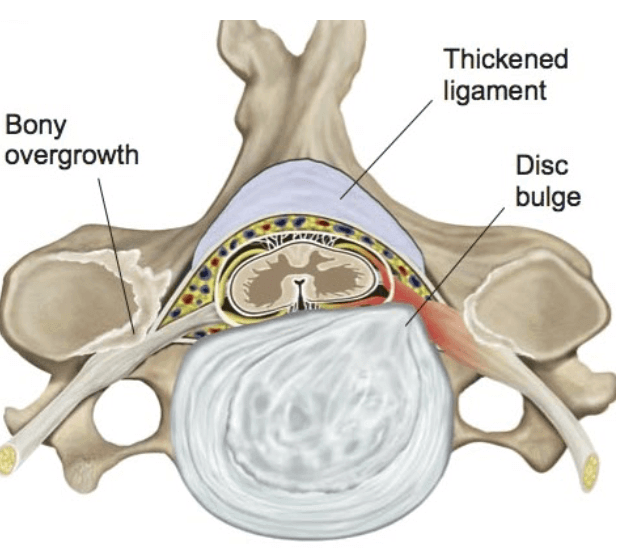Cervical radiculopathy is a condition that occurs when a nerve in the neck (cervical spine) is compressed or irritated, causing pain and other symptoms in the arm or hand. It can be caused by a variety of factors, including herniated discs, bone spurs, spinal stenosis, or degenerative disc disease.
Some examples of conditions that can cause cervical radiculopathy include:
- Herniated Disc: When the soft cushion between the bones in the spine (disc) slips out of place, it can press against a nerve root and cause pain and other symptoms.

- Spinal Stenosis: A narrowing of the spinal canal can put pressure on the spinal cord or nerve roots and cause pain, numbness, and weakness.
- Degenerative Disc Disease: As people age, the discs in the spine can begin to break down and lose their cushioning, which can lead to pain and other symptoms.
- Bone Spurs: Bony growths on the spine can compress nerve roots and cause pain and other symptoms.
The symptoms of cervical radiculopathy can vary depending on the location of the affected nerve root. Common symptoms include:
- Pain: The pain can be sharp, shooting, or burning and can be felt in the neck, shoulder, arm, or hand.
- Numbness: Numbness or tingling can occur in the arm or hand.
- Weakness: Muscle weakness can occur in the arm or hand, making it difficult to grasp or hold objects.
- Reduced Range of Motion: Stiffness and reduced range of motion in the neck can occur.
Treatment options for cervical radiculopathy can vary depending on the severity of the condition. In some cases, the symptoms may improve on their own over time. However, in more severe cases, typical treatment options may include:
- Physical Therapy: Physical therapy can help to strengthen the muscles in the neck and alleviate pain and other symptoms.
- Medications: Over-the-counter pain relievers or prescription medications may be recommended to alleviate pain and reduce inflammation.
- Injections: Steroid injections can be administered directly into the affected area to reduce inflammation and alleviate pain.
- Surgery: In severe cases, surgery may be necessary to alleviate pressure on the affected nerve root.
Chiropractic care is another treatment option that has been shown to be effective in treating cervical radiculopathy. Chiropractors can use spinal adjustments, mobilization, and other techniques to alleviate pain and other symptoms. Chiropractic care is often preferred by many patients because it is non-invasive, has minimal side-effects, and is less expensive than other treatment options.
Chiropractic Care Utilizing Zone Technique for Cervical Radiculopathy
Any Zone Technique healer, including Dr. Post, knows exactly what to do for any condition walking into the office, including cervical radiculopathy. Since Zone Technique is able to unlock and unleash the powerful healing ability withing your body, your healing results will be significantly better than any other healing technique available today. Whether you have or someone else you know has symptoms of cervical radiculopathy, balancing the body by utilizing Zone Technique will heal your body on a very deep level. Zone Technique healing is natural, effective, and permanent so that you will heal completely, function great and no longer have pain. You can be totally healthy again – feeling great and functioning perfectly from head to toe every day of the year!
If you don’t live close enough to see Dr. Post, search for a certified Zone Technique healer closer to you by clicking the link below:
ZONE TECHNIQUE PRACTITIONER DIRECTORY
You owe it to yourself to take action so that you can heal and feel awesome again.
In conclusion, cervical radiculopathy is a common condition that can cause significant pain and other symptoms in the arm or hand. Treatment options vary depending on the severity of the condition, but chiropractic care can be an effective and cost-effective option for many patients. If you or someone you know is suffering from cervical radiculopathy, it is important to seek medical attention to alleviate the pain and other symptoms and prevent further damage to the affected nerve root.

